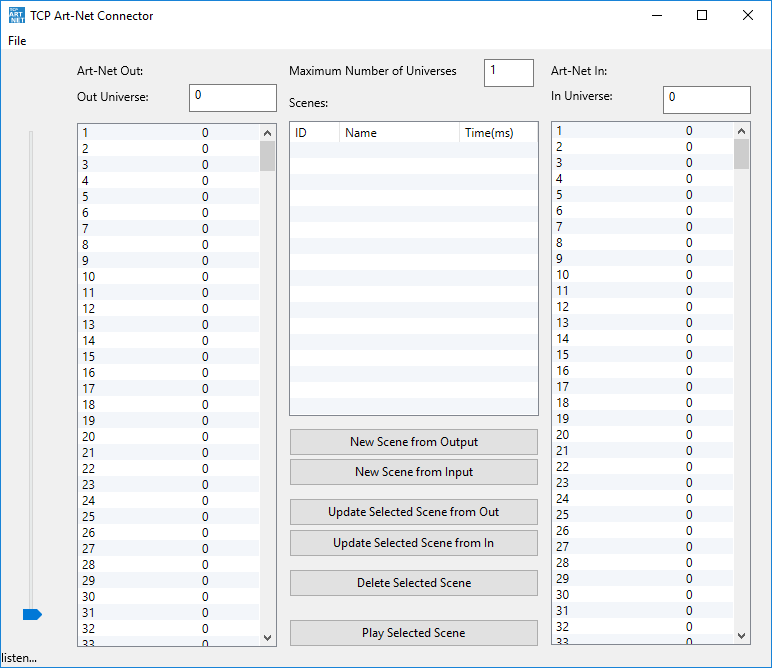Today we released V-Control 4.0.6 and a new TCP Art-Net Connector. The TCP Art-Net Connector is a software that controls up to 256 Art-Net universes on the Art-Net side, and has a simple TCP ASCII interface on the V-Control side.
In V-Control we have new standard device variables that show the channel status and the last command string that was sent to the device
TCP Connectors
For some devices not direct accessible by V-Control, we provide TCP connectors. A TCP connector is a piece of software that controls the device native and provides a network interface to connect to other software products such as V-Control.
So the TCP connector does all the communication with a device internally and provides a simple control protocol via network to communicate with V-Control. This also has the advantage that devices not available via network now network controllable. The V-Control connector is running on a computer where the device is connected to (typically via USB). This can be the same machine where V-Control is running, but doesn’t have to.
Art-Net
V-Control has a very basic native Art-Net Support (Driver Art-Net_v4). For more complex Art-Net / DMX Commands, we have the TCP Art-Net Connector.
As other V-Control Connectors, the TCP Art-Net Connector is a Software that can run on the same machine as V-Control does, but also on a machine somewhere in the network. The last option might be useful if you have to control a huge number of Art-Net universes and channels. The TCP Art-Net Connector is the ideal companion for the Kissbox DMX 1 TR if a DMX interface is needed.
A maximum of 256 universes is supported.
TCP Art-Net Connector runs on Windows 64 Bit, Linux 64 Bit and Raspberry Pi (Model 2 and 3). It has also the capability to read up to 256 universes. TCP Art-Net Connector can be configured to notify V-Control if an input channel has changed, and those changes can trigger V-Control events.
Another useful feature is the ability to capture a static scene. On a button press, the values of all configured Art-Net universes are captured and stored in a scene. V-Control can recall those scenes with a transition time.
V-Control
In V-Control we added two new Device Variables, CH_State (showing the status of a channel, for example open, closed or Error) and Sent (showing the last command string that was sent to a device). On Windows, the Help Menu now works again showing a pdf Help file with the systems default pdf viewer. On Linux this is still broken, but Linux users find the pdf file in V-Control’s Help folder.
Here is a complete list of the change log:
-
Add new Device variable Sent (shows the last command string)
-
Help now works again showing the help file with the default pdf viewer
-
Bugfix: SingleToStr function now works correct in Linux (MemoryBlock.LittleEndian = true)
-
Bugfix: FloatStringToStr function now works correct in Linux (MemoryBlock.LittleEndian = true)
-
Bugfix: Device Variable update was sometimes broken
-
Driver Update: TCP MIDI Connector now works better with high Midi traffic
-
Driver Update: Moxa ioLogic now has additional device variables showing the counter value if inputs are configured as counter
-
New feature: The Engine Status Refresh Timer is now adjustable from 1 to 500 ms
-
Added Reconnect Timer for UDP Sockets that fire in case of Error
-
Change: precompiler Messages are now shown in status bar instead of Splash Screen
-
Added MaximumBuffer option. If the ReceiveBuffer of a channel exeeds this amount then the buffer is cleared
-
Added new DeviceVariable CH_Status which shows the channel status (open, close, error etc.)
-
New Driver: TCP Art-Net Connector
-
New Connector: TCP Art-Net Connector supports up to 256 universes and capturing scenes from input
V-Control Raspberry Pi
We provided a new Raspberry Pi image for download. This image includes the latest V-Control version, but also a copy of the TCP MIDI connector and the new TCP Art-Net Connector. Because the Raspberry’s processor is not very strong, it is not recommended to drive a huge amount of Art-Net universes, but up to 10 should be possible.
The Raspberry image might also be useful if you need to control MIDI devices that are far away from your V-Control machine. In that case, connect the USB MIDI Interface to the Raspberry and launch the TCP MIDI Connector. Locate the Raspberry near the MIDI device you have to control and connect to it via network. On the Raspberry’s desktop there is a file describing how to set the MIDI and Art-Net Connector to autostart.

Leave a Reply
You must be logged in to post a comment.